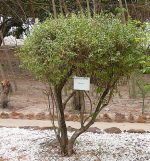 Native to semi-arid and tropical areas of Africa, Asia, and northern Australia, this slender, much branched, evergreen shrub or small tree is also known as mignonette tree and Egyptian privet. It is in the loosestrife family, Lythraceae, that also includes crepe myrtle and pomgranate, and is the only species in the genus Lawsonia. The shrub grows up to 25′ tall and has spine tiped branchlets. The elliptical to lanceolate leaves are .5 to 2″ long and have pointed tips and depressed veins on the upperside. Although considered evergreen, the plant will lose leaves during periods of prolonged dryness or cool temperatures. Small very fragrant white flowers appear from spring to fall and give way to small brownish capsules containing 32 to 49 seeds. The plant has medicinal properties and has been used to treat several ailments including wounds, renal problems, jaundice, leprosy and skin diseases. The leaves have been made into henna dye for more than 5000 years and used to dye skin, hair, fingernails, and fabrics. The genus name, Lawsonia, honors Scottish physician Isaac Lawson, a good friend of Linnaeus. The specific epithet, inermis, in the classical Latin word meaning unarmed [lack of prickles].
Native to semi-arid and tropical areas of Africa, Asia, and northern Australia, this slender, much branched, evergreen shrub or small tree is also known as mignonette tree and Egyptian privet. It is in the loosestrife family, Lythraceae, that also includes crepe myrtle and pomgranate, and is the only species in the genus Lawsonia. The shrub grows up to 25′ tall and has spine tiped branchlets. The elliptical to lanceolate leaves are .5 to 2″ long and have pointed tips and depressed veins on the upperside. Although considered evergreen, the plant will lose leaves during periods of prolonged dryness or cool temperatures. Small very fragrant white flowers appear from spring to fall and give way to small brownish capsules containing 32 to 49 seeds. The plant has medicinal properties and has been used to treat several ailments including wounds, renal problems, jaundice, leprosy and skin diseases. The leaves have been made into henna dye for more than 5000 years and used to dye skin, hair, fingernails, and fabrics. The genus name, Lawsonia, honors Scottish physician Isaac Lawson, a good friend of Linnaeus. The specific epithet, inermis, in the classical Latin word meaning unarmed [lack of prickles].
Type: Evergreen shrub or small tree
Outstanding Feature: Dye from leaves
Form: Vase-shape
Growth Rate: Moderate to rapid
Bloom: Small, very fragrant, white flowers from spring to fall
Size: 6-25′ H
Light: Full sun
Soil: Fertile, medium moist to dry, well-drained
Hardiness: Zones 10-11
Care: The best dye production result from growing plants at temperatures between 95 and 113 F;
Pests and Diseases: Alternaria alternata, Alternaria tenuissima, the beetle Pachnoda interrupta, Phenacoccus solenopsis (cotton mealybug), the aphid Sarucallis kahawaluokalani and Corticium koleroga.
Propagation: Seed
Photo Credit: Wikimedia Commons